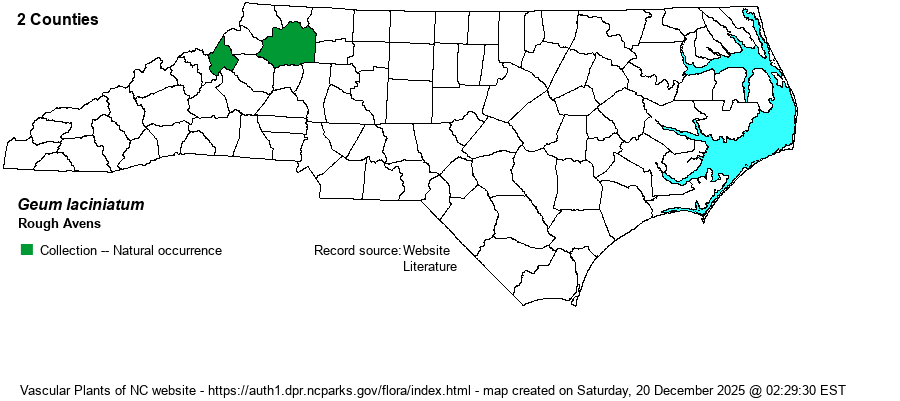| Author | Murray | |
| Distribution | Known only from numerous collections in Avery County, one old collection from Wilkes County, and another sight report from Avery County. A specimen from Jackson County has not been examined by the website editors, and may well be incorrect. At least one other specimen was misidentified as the common G. canadense.
This is a Northeastern species, ranging from Canada south to PA and MO, and then south sparingly in the Appalachian Mountains to northwestern NC and adjacent TN. Records from northwestern SC may be open to question.
| |
| Abundance | Extremely rare. Status essentially as in G. aleppicum, with two known sites in Avery County, though the last dates were 1985 and 2003. Status uncertain for the southern Mountains. As with the other species, the NCNHP has kept the State Rank as S1, and this also is a State Endangered species. | |
| Habitat | This is a wetland species in the state, and it grows in cold to cool water, of mid- to high elevation bogs, seeps, wet places along creek margins, and other boggy places. |
| Phenology | Blooms in June and July and fruits from July to August. | |
| Identification | This species seems to occur in similar places to G. aleppicum, and have very similar ranges in the Eastern states. However, this is a slightly shorter species, growing to about 2 feet tall, very hairy as in that species. It has long basal leaves that are very similar to those of the numerous G. canandense. They can be 6 inches long and strongly pinnate, with highly variable lobing and dissection, with a mix of small leaflets and much larger ones. The stem leaves are gradually smaller, and farther up the stem are usually trifoliate. There are several branches near the top of the stem, and at the tip of each branch grows a single small flower. The 5 sepals are triangular and about 1/4-inch long, but each of the 5 white petals is rounded but equal to or slightly shorter than each sepal. Thus, the white of the flower is not obvious at much distance, especially as much of the middle of the flower is the large green receptacle. The very similar G. canadense has petals normally 1.5 times longer than the sepals, and more distinctly a white-flowered species. G. laciniatum has strongly hairy flower stalks, whereas G. canadense has only short pubescence along the stalk. Also, this species has strongly hairy stems, whereas G. canadense has stems mostly smooth or with some pubescent toward the base. Other Geum species have generally pale yellow or bright yellow flowers, or different leaves. As with the extremely rare (in NC) G. aleppicum and G. vernum, do not attempt to identify these three very rare NC wetland species just by their leaf and stem characters. Sadly, very few biologists (who are still alive) have seen any of these three in the state. | |
| Taxonomic Comments | Many references list varieties for this species, but Weakley (2018) chooses not to.
| |
| Other Common Name(s) | None | |
| State Rank | S1 | |
| Global Rank | G5 | |
| State Status | E | |
| US Status | | |
| USACE-agcp | FACW link |
| USACE-emp | FAC link |

